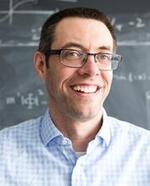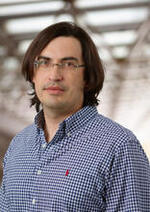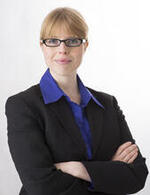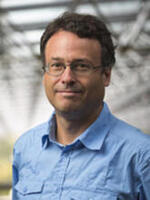 Will Percival, professor of physics and astronomy and member of the Waterloo Centre for Astrophysics, was recognized by the Clarivate organization as one of the top researchers in the world last year.
Will Percival, professor of physics and astronomy and member of the Waterloo Centre for Astrophysics, was recognized by the Clarivate organization as one of the top researchers in the world last year.
Prof. Percival studies the large-scale structure of the universe, working with large survey datasets. One particular focus is trying to understand the mysterious dark energy that makes up 70% of the universe.
Clarivate compiles statistics on highly influential papers, and names as top researchers the rare group of people who have published multiple highly influential papers in the previous decade.
As they say in the press release, these folks are really one in a thousand!
 Shayan Majidy, a PhD candidate in the Department of Physics and Astronomy, has earned the prestigious Vanier Scholarship award for his research achievements and his work in quantum computing education.
Shayan Majidy, a PhD candidate in the Department of Physics and Astronomy, has earned the prestigious Vanier Scholarship award for his research achievements and his work in quantum computing education.
Maijdy, currently studying under Professor Raymond Laflamme, and also a member of the Institute for Quantum Computing (IQC), has been interested in two questions during his PhD: what are the limitations to our current tests of quantum behaviour; and can we gain a thermodynamic advantage from quantum mechanics?
Vanier scholars are chosen based on their academic excellence, research potential, and leadership qualities.
>> Read more in the Faculty of Science news.
 Donna Strickland was inducted into the Pontifical Academy of Sciences by Pope Francis. With its origin reaching back to 1603, the Pontifical Academcians consist of eighty members nominated by the Holy Father, each having made an outstanding contribution to research in their respective fields. Though the Academy stems from papal initiative, it remains non-sectarian, in areas that range from pure research, to concerns with the ethical and environmental repercussions of scientific development, all the while placing importance on interdisciplinary collaboration.
Donna Strickland was inducted into the Pontifical Academy of Sciences by Pope Francis. With its origin reaching back to 1603, the Pontifical Academcians consist of eighty members nominated by the Holy Father, each having made an outstanding contribution to research in their respective fields. Though the Academy stems from papal initiative, it remains non-sectarian, in areas that range from pure research, to concerns with the ethical and environmental repercussions of scientific development, all the while placing importance on interdisciplinary collaboration.
Prof. Strickland’s research in ultrafast optics has received many awards, most notably the 2018 Nobel Prize in Physics for developing chirped pulse amplification with Gérard Mourou. Their work, published in 1985, has led to several advancements in high-intensity laser applications; specifically, those used in corrective eye surgeries.
>> Learn more about the Pontifical Academy of Sciences
 An international team, including Prof. Dmitry Pushin of the Department of Physics and Astronomy and the Institute for Quantum Computing (IQC), managed to measure three important quantities with one experiment. By sending a beam of cold neutrons through silicon crystals carved with atomic precision, they are able to observe interference patterns of neutrons, analogous to Young’s double slit pattern in optics, but using a fundamental matter particle instead of light. While neutron interference effects have been known for decades, the team pushed to unprecedented accuracy last year, allowing them to measure the charge radius of the neutron and the lattice constant of a silicon crystal better than ever before. At the same time, they were also able to constrain several theories for what comes beyond the standard model of particle physics that would introduce new forces to the universe.
An international team, including Prof. Dmitry Pushin of the Department of Physics and Astronomy and the Institute for Quantum Computing (IQC), managed to measure three important quantities with one experiment. By sending a beam of cold neutrons through silicon crystals carved with atomic precision, they are able to observe interference patterns of neutrons, analogous to Young’s double slit pattern in optics, but using a fundamental matter particle instead of light. While neutron interference effects have been known for decades, the team pushed to unprecedented accuracy last year, allowing them to measure the charge radius of the neutron and the lattice constant of a silicon crystal better than ever before. At the same time, they were also able to constrain several theories for what comes beyond the standard model of particle physics that would introduce new forces to the universe.
The study, Pendellösung Interferometry Probes the Neutron Charge Radius, Lattice Dynamics, and Fifth Forces, was published this past September in the journal Science. “This was a multi-year experiment, and we had great results that are technically exciting and opens the door to future technologies,” said Pushin.
>> Read more from the IQC - Groundbreaking Technique Yields Important New Details on possible ‘Fifth Force’
 The Quantum Interactions Group, led by Prof. Christine Muschik from the Department of Physics and Astronomy and IQC, performed the first ever quantum simulation of baryons.
The Quantum Interactions Group, led by Prof. Christine Muschik from the Department of Physics and Astronomy and IQC, performed the first ever quantum simulation of baryons.
Baryons are an important class of particles, including the protons and neutrons that make up the nucleus of an atom. Their structure is extremely difficult to calculate using classical computers because of the strong interactions between the quarks and gluons they are built from.
Muschik’s team developed an efficient way to simulate this complex structure using a quantum computer. Then they ran their simulations on a publicly available quantum computer from IBM. This first step lights the path to unravelling the mysteries of nuclear matter, from simple nuclei to massive neutron stars. The paper, SU(2) hadrons on a quantum computer via a variational approach was published in Nature Communications in November.
>> Learn more at Phys.org - Researchers achieve first quantum simulation of baryons
 The Quantum Encryption and Science Satellite (QEYSSat) project, led by Prof. Thomas Jennewein from the Department of Physics and Astronomy and IQC, received a huge joint funding award from Canada and the UK. The funding will bring them further on the path to launch of this ambitious space mission that will demonstrate quantum secured communication across the Atlantic. The satellite, expected to launch next year, will be able to exchange entangled photons with ground stations in Canada and the UK. This will enable groups on opposite sides of the ocean to exchange information with security guaranteed by the most fundamental laws of physics. While quantum computers may some day be able to break our current techniques for encryption, the same weird quantum effects that allow them to do this can be harnessed to make unbreakable encryption. QEYSSat will help make that secure future a reality.
The Quantum Encryption and Science Satellite (QEYSSat) project, led by Prof. Thomas Jennewein from the Department of Physics and Astronomy and IQC, received a huge joint funding award from Canada and the UK. The funding will bring them further on the path to launch of this ambitious space mission that will demonstrate quantum secured communication across the Atlantic. The satellite, expected to launch next year, will be able to exchange entangled photons with ground stations in Canada and the UK. This will enable groups on opposite sides of the ocean to exchange information with security guaranteed by the most fundamental laws of physics. While quantum computers may some day be able to break our current techniques for encryption, the same weird quantum effects that allow them to do this can be harnessed to make unbreakable encryption. QEYSSat will help make that secure future a reality.
>> Read more from IQC - Testing quantum-secure communication in space.






